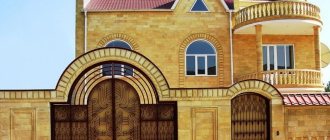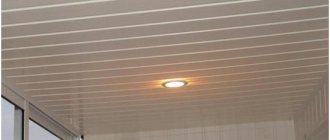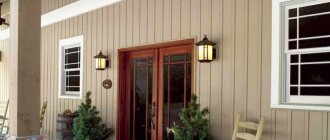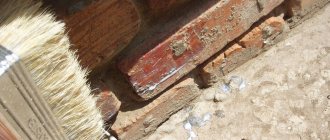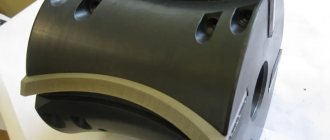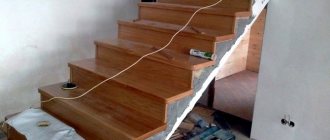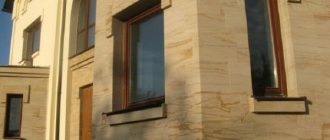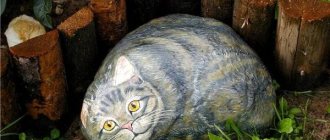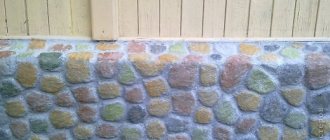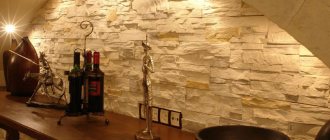Sometimes you want your house to look not modern, but, on the contrary, to look like an ancient building built in the Middle Ages. But at the same time, his appearance must be attractive and impeccable. A finishing material such as wild stone for the facade, which is far from new but still popular, will help achieve this. This expensive, but unique and beautiful material deserves special attention.
Wild stone for facade
Wild stone combined with dolomite
Facade finishing with limestone
Features of wild stone as a finishing material
Wild stone, as you might guess, is a material created by nature itself. It was formed over a long period of time – thousands of years – under the influence of various natural factors. It is distinguished by a rich range of colors, allowing you to create the most unusual combinations and variations of building facade cladding. This type of natural cladding material is made from large slabs of stone that are split into many small pieces. All the resulting fragments have completely different shapes and sizes, torn edges, their surface is rough and uneven. It is interesting that in a huge pile of such stones there will not even be a pair of identical ones - they are all somehow different from each other.
Natural stone
On a note! Transporting wild stone, despite its weight, is very convenient, since it has a flat shape and is easily stored.
Wild stone as a finishing material has several features that significantly distinguish it from other types of finishing:
- its manufacturer is nature itself; at its processing plants it simply breaks into pieces;
- the material has a lot of application possibilities;
- the stone is unique. Even if you use pieces of the same type, they will still differ from each other;
- the technological stone slab has dimensions of 30*60, 30.5*30.5 or 40*40 cm, and its thickness is about 1-3 cm;
- The texture of wild stone is special - it cannot be imitated by any method of finishing a façade.
Natural stone finishing
FASTENING PARTS FOR CONNECTING cladding elements TOGETHER
Elements of external and internal cladding are connected to each other and to the wall with metal pins, staples, clamps, and fasteners. All of them must be protected from corrosion. To do this, steel elements are pre-coated with a layer of zinc or aluminum. It is prohibited to bend the fasteners after applying the anti-corrosion coating. Some structures use fasteners made of stainless steel, non-ferrous metals and alloys (copper, bronze, brass).
Adjacent elements of the external and internal cladding are connected end-to-end, stepped and wedge-shaped. When connecting end-to-end, the stones are in contact with their end faces; for slab thicknesses up to 150 mm, steel pins and staples can be used to eliminate relative displacements. Pins (pyrons) are made of round steel with a diameter of 3-8 mm and a length of 30-60 mm and are used in horizontal and vertical seams. The pins are inserted into sockets drilled in adjacent cladding elements to half their length. Staples are made of round or strip metal. They are placed in horizontal or vertical joints perpendicular to the plane of the slabs. In order not to increase the thickness of the seam, grooves are cut in the slabs and staples are inserted into them.
Fasteners for connecting stones to the wall. The cladding is connected to the wall with metal anchors and fasteners, which are simple and combined hooks, pins, staples, etc. A simple hook is made of round stainless steel with one curved end. The dimensions of the hook depend on the size of the cladding element. The hooks are installed in horizontal rows, two pieces per slab. The depth of installation of hooks into the wall must be at least 100 mm.
Combined hooks are made of stainless steel and are used to simultaneously connect cladding elements to each other and to the wall. In each horizontal row, two of them are installed in a slab. For fastening marble, dolomite, limestone slabs, mainly brass, copper, copper-plated anchors or stainless steel anchors are used.
To reduce the load and protect the supporting row from deformation during wall shrinkage, it is recommended to cladding multi-storey buildings in tiers. The unloading support row can be installed on the structural elements of the wall being lined and separated from the underlying tier by an expansion joint 5-15 mm wide. In claddings that are installed on a finished wall, the unloading row is supported on steel elements made of angle steel, fixed in the load-bearing wall. If the seam is left open at this joint, it is filled with sealant. For individual stone structures, fastenings are specially designed.
Advantages and disadvantages
Wild stone as a finishing material has its pros and cons. And before you make a decision regarding finishing the house with it, you should get acquainted with its features. This will help you make the right choice.
How do stones appear in nature?
Advantages of wild stone for facade finishing:
- due to the fact that stone is a natural material, it is absolutely safe for the environment and human health, that is, it is environmentally friendly;
- the ability to create a unique pattern on the wall;
- this natural material is characterized by high durability, it does not fade or collapse;
- the protective abilities of wild stone can be envied by any finishing material - the stone is not afraid of wind, rain, snow;
External laying of wild stone
- it does not react to temperature changes, and at the same time it allows you to provide a favorable microclimate in the house at any time of the year - in summer it keeps the building cool inside, and in winter, on the contrary, it retains heat well;
- natural stone “breathes”, especially for such types of material as sandstone and shell rock. This feature also has a positive effect on the microclimate in the house;
- It is relatively easy to cladding the facade yourself - you can glue stones to the wall even on uneven surfaces, in a chaotic manner;
- The façade, finished with natural stone, looks impressive, noble and impressive.
Facade facing with stone
On a note! There is an opinion that some types of natural stone are radioactive. However, this is far from true - this fairy tale was invented by competitors selling other types of finishing materials. So you can safely buy wild stone and use it to decorate your home.
Now a few words about the disadvantages of wild stone. This material is quite durable and heavy. The first, of course, is also its advantage, but it significantly complicates processing and cutting if necessary. But not all types of finishing stone are heavy. But the price of natural materials is quite high - for example, marble or granite (1 m2) will cost at least 1,400 rubles, and sandstone - from 230 rubles.
It is worth remembering that not a single method of artificial imitation of stone can convey the charm and beauty that natural material possesses. The stone received its design and texture thanks to the centuries-old “labor” of water, air, high temperatures in the bowels of the earth, and other natural factors. That is why facades with such finishing will always look unique and are considered an indicator of the taste of the home owner. This type of decoration will never go out of fashion.
Artificial stone will not be able to convey the charm and beauty that natural material possesses.
Prices for various types of facing stone
Facing stone
Sandstone
Svidu is very similar to limestone, but stronger and more reliable. Compared to other types of materials, it is lighter, which makes it possible to use it in interior decoration.
You can find several types of sandstone on the market today:
- Oolitic;
- Pisolite;
- Shell rock;
- Lithographic.
However, only oolitic and pisolite are suitable for our work. The other two are used in the construction of foundations and walls of buildings.
Types of stone
A large number of types of wild stone are used to decorate the facades of residential buildings and other buildings. They differ from each other in processing complexity, strength indicators, appearance and many other factors. Each type has its own disadvantages and advantages.
Table. Types of wild stone used for finishing facades.
| View | Characteristic |
Granite | This is the most durable and expensive type of stone. It does not age, is not affected by any natural factors, and looks very expensive. Granite has always been considered a symbol of wealth, reliability, and strength. Its main drawback, in addition to the high price, is its heavy weight, which makes the installation process extremely complicated and expensive. Granite is a rock of igneous origin. |
Limestone | Limestone is distinguished by its relatively small mass. The stone is of organic origin; it is the compressed remains of shells of sea creatures. The stone contains a large amount of calcium. It has good decorative properties, is environmentally friendly, relatively lightweight, and has high levels of sound and heat insulation. Limestone also has bactericidal properties - it purifies the air from pathogenic microorganisms. The price is lower than that of granite. At the same time, the stone is well processed. By the way, shell rock is a type of limestone. The disadvantage is that limestone must be treated with water repellents. |
Sandstone | The stone has an attractive appearance and is relatively inexpensive. It is pleasant, slightly rough to the touch, has a beige, yellowish color, or less often dark brown. Wear-resistant, but cannot be polished. By the way, palaces and royal chambers were previously created from this stone. And even now sandstone is one of the most popular types of finishing stone. |
Marble | Dense, strong, easy to process, very beautiful looking finishing stone. But it is extremely difficult and capricious to use; under certain conditions it can become stained and lose its appearance. It consists of calcite and is formed due to the processes of limestone metamorphism. |
Labradorite | Frost-resistant, strong and reliable finishing material that can be polished. This is an igneous rock, has a beautiful blue, less often yellow or red pattern. |
Syenite | The rock is of igneous origin, very durable, not afraid of heat and fire, and can be polished. Light, porous. Disadvantage: it wears off relatively quickly. |
Porphyry | This is a series of rocks that are dark red in color and smooth to the touch. Its chemical composition is similar to granite. Durable, non-fading rock, highly polishable. It was used in ancient Rome - statues and luxury items were made from porphyry. |
Quartzite | Difficult to process material with a light or reddish tint. Very heavy, so rarely used. |
Dolomite | It is not afraid of fire or frost, a very beautiful mineral. Disadvantages: high price, small selection of colors. |
Slate | It is not afraid of water, frost, sudden temperature changes, and is not destroyed during mechanical processing. It has black, green, gray, bluish colors. Laminated material. |
Which stone is better?
All rocks differ from each other in terms of strength, appearance, resistance to various influences, price and complexity of processing. Most often, limestone, sandstone, slate are used for cladding buildings; granite is the most expensive and difficult to process.
It is very difficult to single out among them the one that can be called the best of all. You need to be guided by your wishes regarding appearance, the possible amount of expenses and other factors. If possible, it is better to buy granite or marble, but if you don’t have enough money for them, then you can buy sandstone.
Sandstone for facade cladding
Granite
In terms of price and external characteristics, it is on par with marble. It comes in both glossy (polished) and matte (not polished). It looks very impressive next to nature.
Granite can be divided into three types based on color scheme:
- Plagiogranite - gray shades predominate;
- Alaskite - reddish-pink shades predominate;
- Porphyritic granite is a cross between the other two types.
Main stone formats
There are five main types of stone that are used to decorate facades:
- tile called “Euro-2”, measuring 60*30*2 cm. It is the most popular type of material;
- slabs The most expensive type of facing stone. Made from solid stone blocks;
- wild stone. These are layers that have an irregular shape, the corners of which are carefully processed;
- die - stones are made from pieces of material. It looks very nice, but installation of tiles is more expensive than tiles;
- Moscow fur coat - the parameters of these stones are approximately the same, but the stones themselves have torn edges on the main side. One of the most expensive types.
Wild stone sandstone (die)
Where is it used?
Wild stone is used not only for facade decoration. It is suitable for decorating the basement of buildings; it can also be used to decorate walls from the inside of the room. The openings of windows and doors trimmed with wild stone also look very beautiful. Floors made of natural mineral, fireplaces, columns and other decorative elements decorated with it will also look good.
On a note! Entire façade walls are rarely finished with wild stone, as this process is lengthy, labor-intensive and expensive.
Wild stone goes well with forged metal products, so you can add grilles and lanterns of various shapes made from alloys to the wall of the house.
Cladding steps and plinth with wild stone
Finishing technologies
There are two ways to decorate the facade with wild stone - with jointing and seamless. In the first case, you will get a beautiful pattern formed from stones loosely fitted to each other and a mortar holding them together. In the second case, the seams will not be visible, but the stones should fit very tightly to each other. The first option saves the consumption of the finishing material itself.
On a note! Before you start covering the walls with stone, it is important to evaluate the material from which the wall is made. The fact is that placing a stone directly on a surface is only possible if it is made of brick or concrete. If the facade of the building is wooden, then before installation it should be covered with a special mesh.
Facing with wild stone photo
Preparing the surface for installation
A properly prepared wall for stone installation will ensure reliable adhesion of the adhesive composition and good adhesion of the material.
The preparatory stage is as follows:
- it is necessary to level the walls;
- plaster protruding elements, seal cracks (applies to concrete and brick walls);
- remove nails, secure boards, replace moldy elements, waterproof and lay reinforced mesh (for wooden walls).
IMPORTANT! For wooden surfaces, it is recommended to install a continuous sheathing on the frame, on which the stone elements will then be laid.
The walls are plastered, sanded, primed, and then an adhesive is applied to which the facing elements are glued.
We decorate the facade with natural stone
After the stone has been selected, purchased, and delivered directly to the construction site, it is sorted, removing too small and fragile pieces from the total. In general, the entire stone is divided into several piles, in which elements of approximately the same size are collected. Next begins the preparation of the facade and its facing with stone. Work should be carried out at positive temperatures so that the base is heated to +5-30 degrees.
Step 1. First of all, the facade is carefully examined. The surface must be durable and dry.
Façade inspection
Step 2. Next, the surface is cleaned of dust and debris using a brush. All major irregularities are eliminated.
Surface cleaning
Step 3. All large cracks are puttied. If there are greasy stains or paints, they are removed with a solvent.
Putty of large cracks
Step 4. Apply one layer of primer to the prepared surface (two layers to a porous surface). It is necessary to wait time for the primer to dry.
Applying primer
Step 5. Before starting work, the wild stone is washed with water using a stiff brush and dried. This way, dust will be removed from it, which reduces the adhesion of the stone.
Wild stone is washed
Step 6. A special dry adhesive mixture is used to glue the stone. It is diluted immediately before starting work strictly according to the instructions given on the packaging. The required amount of the mixture is dissolved in water and mixed using a construction mixer.
Preparation of the adhesive solution
Step 7. The grout for the joints is immediately prepared from a special mixture. It can be given the desired color using tint.
Grout preparation
Attention! The mixtures harden very quickly, so you need to work quickly and carefully. And it’s better not to dilute the entire solution at once.
Construction mixer price
Construction mixer
Step 8. The prepared mixture is applied to the wall and then leveled with the notched side of the spatula.
The mixture is applied to the wall
Leveling with a notched trowel
Step 9. The stone is applied to the applied solution and pressed. You can lightly tap it with a rubber mallet.
The stone is pressed against the applied mortar
Step 10. A thick layer of grout is applied to the edges of the glued stone.
Applying grout
Step 11. The next stone is applied.
The next stone is applied
And one more
Step 12. Excess protruding grout is removed with a spatula.
Removing excess grout
Step 13. After a day, the remaining grout is removed from the surface with a wet brush.
Remains of grout from the surface are removed with a wet brush.
Step 14. The final stage of finishing is applying varnish. This will highlight the natural color of the stone and also protect it from moisture.
Varnish for stone and structural plaster
Artificial stone for plinth
Finishing the basement is a separate task to which a good owner of a country cottage will definitely pay a lot of attention. Most often, decorative stone is used for these purposes - an expensive material that not everyone can afford in large quantities. But today the material has a cheaper alternative that is not inferior in its performance characteristics. This is an artificial stone for a plinth.
Recommendations for decorating a house with plaster
Plaster work on the facade, especially in the case of subsequent partial cladding, must be carried out with special care. Any height difference or unevenness on the surface will spoil the whole picture. Almost all decorative coatings need ideally smooth walls, with a few exceptions - lamb and fur coat are more tolerant of the ideal. The discrepancies can be no more than 2 cm. How to achieve this? We will try to give clear recommendations.
- Prepare the wall by removing all old cladding, paint, and plaster. If the plaster holds up well, then you can repair it and level the top layer.
- Examine the wall. If the unevenness is 3 cm or more, we recommend using beacons for the first rough leveling layer:
- The surface is primed.
- If the insulation is not applied, then you can proceed to the next stage.
- Metal or wooden slats are attached at equal intervals. A cord is stretched between them.
- The solution should have the thickness of a good jelly, but not too thick.
- The plaster is thrown onto the wall with a trowel and smoothed with a trowel. All this is done between the beacons in accordance with the cord that indicates the plane.
- The first layer must dry, after which primer and mesh adhesive are applied. You can do it differently: the mesh is immersed on the first layer of plaster that has not yet dried, but the first option is preferable.
- Next, a leveling layer of finishing plaster is applied. If this is a decorative textured mixture, then it is leveled with a grater or roller according to the provided technology, which is described on our website in separate articles.
Layered plaster “pie” with insulation
